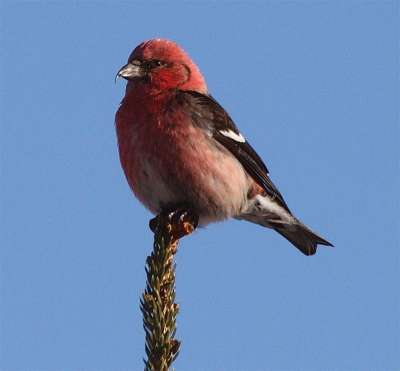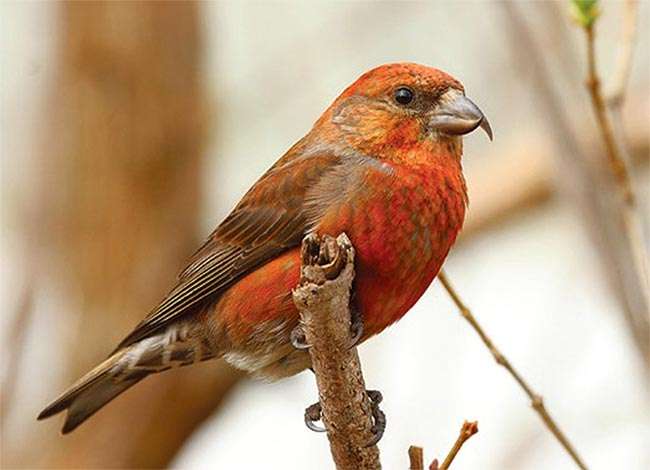Even among the quirky cast of characters we know as birds, the crossbill is a bit of a freak. It’s hard to decide which is more bizarre: its bill or its breeding behavior.
Front and center is the bill. Faithful to its name, the crossbill’s mandibles cross at the tip, sort of like a misaligned pair of needle-nosed pliers. It’s a unique departure from the avian blueprint and no other bird shows this twisted visage.
Crossbills are finches, the males apple red with dark wings, the females and young yellow-green. Two of the planet’s crossbill species inhabit North America: the white-winged crossbill (with white bars on those dark wings) prefers seeds from spruce and tamarack (and isn’t particularly fond of balsam fir); the red crossbill, whose bill size and shape varies around the continent, enjoys a more diverse diet, including pine and fir species and eastern hemlock.
The crossbill turns the odd-looking beak into a mega-tool for prying apart the scales of cones to expose the seeds within. First, the bird bites down to open a gap in the scales, like reverse pliers opening at the tip when you squeeze them. With its bill now wedged behind a scale, the crossbill tilts it head to open the gap wider as it digs deeper, sort of like when you insert a flat-head screwdriver into the seam of a paint-can lid and twist. But the crossbill does the screwdriver one better by spreading its upper and lower mandibles laterally to help widen the gap even more as it approaches its quarry. Once it gets to the base of the scale, the crossbill lifts the seed out with its tongue (sometimes with an assist from the hook of its upper mandible), breaks away and discards the husk, and swallows its meal whole.
If the extraction seems laborious, crossbills pull it off with the skill of an assembly line worker, eating as many as 3,000 conifer seeds in a day. Out there foraging in boughs full of cones, crossbills also use their bills to grab branches and needles as they climb, making them look a bit like parrots walking and feeding in the conifers.
The crossbill’s determination with seeds reveals an urgency beyond routine foraging; it allows them to breed at any time of year. Among virtually all songbirds, day length – the photoperiod – triggers hormone production to bring on breeding. Longer, warmer days in spring, along with a burst of food availability (insects, fruits, and seeds) provokes birds to sing and reproduce. For crossbills, however, the proximate trigger for breeding is food availability. When the boughs hang heavy with cones, crossbills can get the calories essential for reproduction – from egg production to feeding young – even as snow coats the cones. Those high-calorie conifer seeds stoke fires in their bellies.
Although white-winged crossbills can breed in the cold, relative cone abundance suggests three preferences – or breeding cycles – here in the Northeast: the first during the development of new cones in July and August; the second from January to March, focus when spruce cones might be all that’s available; and the third in March, when black spruce cones are hanging on after red and white spruce cones have dropped.
Crossbills are vagabonds, wandering south some winters from the boreal core of their range in search of cones. When they find a source of seeds, the birds gather and feed together in groups. During my own wanderings in Maine and Vermont this fall I saw heavy cone crops, particularly on white and red spruce, which means crossbills may be here in abundance this winter. So you might not need to wait until spring to find breeding songbirds.



